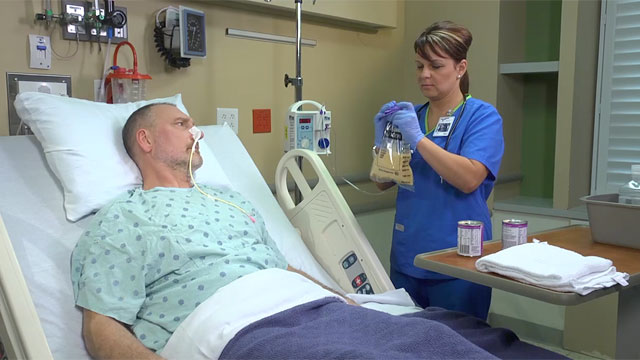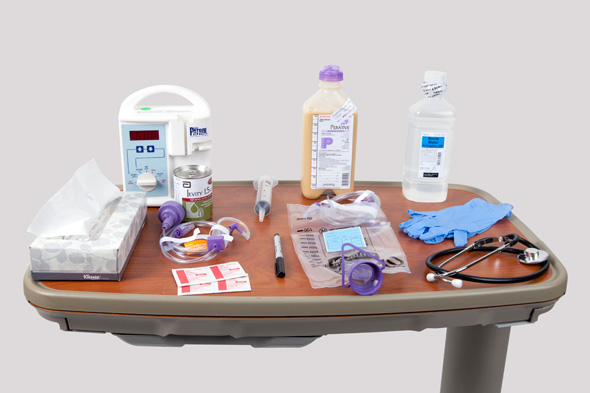Enteral Nutrition
Select a Skill:
Take the Review Test:

Safety
- Maintaining and monitoring the tube location during feeding and keeping the head-of-bed elevation at a minimum of 30 degrees—and preferably 45 degrees—reduces aspiration incidents and subsequent pneumonia.
- Do not adjust the feeding rate; infuse the feeding as ordered.
- A sudden gain of more than 2 pounds in 24 hours usually indicates fluid retention.
- If the patient aspirates formula, do the following:
- Report the change in patient condition to the health care provider; if there has not been a recent chest x-ray film, suggest ordering one.
- Prepare for possible initiation of antibiotics.
- If the patient develops nausea and vomiting, which may indicate paralytic ileus:
- Withhold the tube feeding, and notify the health care provider.
- Be sure that the tube is patent; aspirate for residual volume.
Equipment
(Roll cursor over items to see labels)

Disposable feeding bag, tubing or ready-to-hang system
Disposable feeding bag, tubing or ready-to-hang system
30 mL or larger catheter-tip syringe
Stethoscope
Enteral infusion pump for continuous feedings
Prescribed enteral formula
Clean gloves
Alcohol swabs
Permanent marker
500 mL of water
Tissue
Delegation
The skill of administering a nasoenteric tube feeding can be delegated to NAP, according to your agency’s policy. However, a registered nurse (RN) or licensed practical nurse (LPN/LVN) must first verify tube placement and patency. Be sure to inform NAP of the following:
- Elevate the head of the bed at least 30 degrees, and preferably 45 degrees, or help the patient sit up in the bed or a chair.
- Infuse the continuous feeding on the pump as ordered.
- Report any difficulties infusing the feeding or any discomfort voiced by the patient.
- Report any gagging, paroxysms of coughing, or choking.
- Provide frequent oral hygiene.
Preparation
- Assess the patient for food allergies.
- Perform a physical assessment of the abdomen, including auscultation for bowel sounds, before feeding.
- Obtain a baseline weight, and review serum electrolytes and blood glucose measurement. Assess the patient for fluid volume excess or deficit, electrolyte abnormalities, and metabolic abnormalities such as hyperglycemia.
- Verify the health care provider’s orders for the type of formula, rate, route, and frequency.
- Explain the procedure to the patient.
Follow-up
- Measure gastric residual volume (GRV) according to your agency’s policy, usually every 4 to 6 hours. Ask the patient if he or she has had any nausea or abdominal cramping.
- Monitor the patient’s intake and output at least every 8 hours, and calculate daily totals every 24 hours.
- Weigh the patient daily until the maximum administration rate is reached and maintained for 24 hours, and then weigh the patient three times per week.
- Monitor laboratory values.
- Observe the patient’s respiratory status.
- Auscultate bowel sounds.
- For tubes placed through the abdominal wall, inspect the site for signs of impaired skin integrity.
- If the nasogastric tube is unable to be flushed with normal saline, obtain a product designed specifically to unclog a nasogastric tube.
Documentation
- Record and report the amount and type of feeding, method of infusion, patient’s response to tube feeding, gastric residual volume (GRV), cramping, patency of tube, and condition of the skin at the tube site.
- Record the volume of formula and any additional water on the patient’s intake and output form.
- Report the type of feeding, the status of the feeding tube, the patient’s tolerance, and any adverse outcomes.
Review Questions
1. Why does the nurse elevate the head of the bed to 30 degrees for a patient receiving an intermittent tube feeding?
 Elevating the head of the bed reduces the risk for aspiration.
Elevating the head of the bed reduces the risk for aspiration. Proper elevation of the head of the bed promotes the patient’s digestion.
Proper elevation of the head of the bed promotes the patient’s digestion. Acid reflux is reduced when the head of the bed is elevated at least 30 degrees.
Acid reflux is reduced when the head of the bed is elevated at least 30 degrees. Nutrients are absorbed more efficiently when the head of the bed is elevated.
Nutrients are absorbed more efficiently when the head of the bed is elevated.
2. What is the proper response to the nurse’s observation that the patient’s closed-system enteral feeding has 150 mL of formula remaining and that the infusion order rate is for 50 mL/hr?
 Recalculate the present drip factor for accuracy.
Recalculate the present drip factor for accuracy. Terminate the fluid, and prepare to hang a new bag of formula.
Terminate the fluid, and prepare to hang a new bag of formula. Plan to check the feeding for completion within the next 3 hours.
Plan to check the feeding for completion within the next 3 hours. Check with the pharmacy to see if the formula has been hanging too long.
Check with the pharmacy to see if the formula has been hanging too long.
3. After unsuccessfully attempting to flush a nasogastric (NG) tube with water, what is the most appropriate action for the nurse to take?
 Flush the tube with ginger ale.
Flush the tube with ginger ale. Use apple juice to flush the tube.
Use apple juice to flush the tube. Obtain a product designed to unclog NG tubes.
Obtain a product designed to unclog NG tubes. Force-flush the system with sterile normal saline.
Force-flush the system with sterile normal saline.
4. How could the nurse assess the patency of a nasogastric (NG) tube being used for enteral nutrition?
 Elevate the head of the patient’s bed to at least 30 degrees.
Elevate the head of the patient’s bed to at least 30 degrees. Use an intravenous fluid infusion set.
Use an intravenous fluid infusion set. Check the gastric residual volume.
Check the gastric residual volume. Monitor the amount of intake the patient tolerates in an 8-hour period.
Monitor the amount of intake the patient tolerates in an 8-hour period.
5. Which nursing action is appropriate when feeding gastric residual is 50 mL?
 Return it to the stomach via the feeding tube.
Return it to the stomach via the feeding tube. Dispose of the residual contents down the commode.
Dispose of the residual contents down the commode. Discard the stomach contents as a liquid biohazard.
Discard the stomach contents as a liquid biohazard. Return half of the volume to the stomach, and discard the rest.
Return half of the volume to the stomach, and discard the rest.
You have completed the Review Questions for this skill. To take the Review again select the Start Over button. To proceed to another skill select from the dropdown menu. Select the Home or Back button to proceed to the next section.

